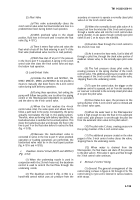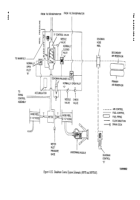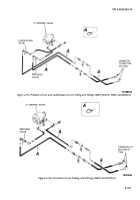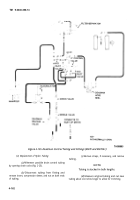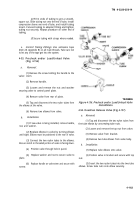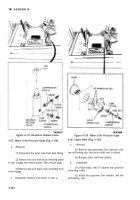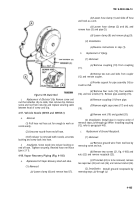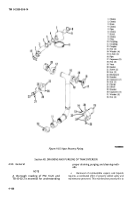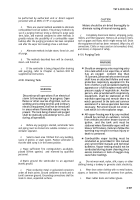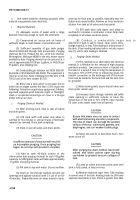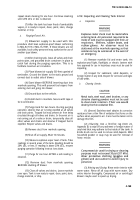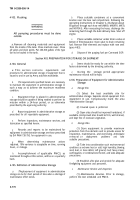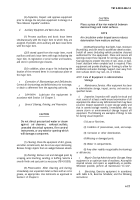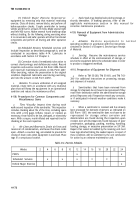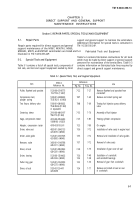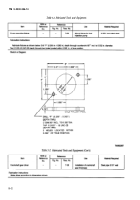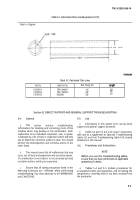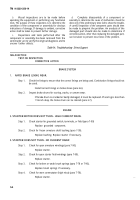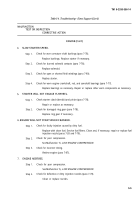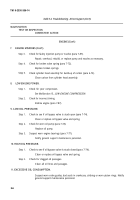TM-9-2330-356-14
SEMITRAILER, TANK: 5000 GALLON, BULK HAUL, SELF LOAD/UNLOAD M967 AND M967A1; SEMITRAILER, TANK: 5000 GALLON, FUEL DISPENSING, AUTOMOTIVE M969 AND M969A1; SEMITRAILER, TANK: 5000 GALLON, FUEL DISPENSING, UNDER/OVERWING AIRCRAFT M970 AND M970A1
TECHNICAL MANUAL; OPERATOR’S, UNIT, DIRECT SUPPORT, AND GENERAL SUPPORT MAINTENANCE MANUAL
OCTOBER 1990
TM-9-2330-356-14 - Page 305 of 528
TM 9-2330-356-14
repeat steam cleaning for one hour. Continue steaming
until 20% LEL or less is obtained.
(7) After the tank has been freed of combustible
vapors, it is ready to repair, clean, paint, store, change
material, or ship.
h.
Purging-Forced Air.
(1) Blower/air supply to be used with this
procedure shall bean explosion-proof blower conforming
to MIL-B-7619 or MIL-H-27507. If these blowers are not
available, local safety personnel may authorize the use of
another type blower.
(2) After draining tank, leave all valves and drain
points open, and grounded drain containers in place to
catch fuel during the purging operation. This is to
facilitate maximum air circulation.
(3) Place blower/air supply SO-feet upwind of
semitrailer. Ground the blower to the static ground and
connect duct to outlet side of blower.
(4) Start blower BEFORE inserting duct into
manhole opening. This will prevent fuel vapors from
entering duct and going into blower.
(5) Ground duct to the vehicle.
(6) Install duct in manhole. Secure with tape or
tie to semitrailer.
(7) Purge tank for two hours. During purging
operation, observe that air is being expelled at all valves
and drain points. Trapped fuel may prevent air from being
circulated through all valves and drains. In the event air is
not coming out of a valve or drain, temporarily close all
other valves and drains and observe if trapped fuel is
expelled. Reopen valves and drains.
(8) Remove duct from manhole opening.
(9) Shut off air supply. Wait 10 minutes.
(10) Measure explosive vapor level of tank. Take
readings in several areas of the tank. Reading should be
20% LEL or less. If reading is above 20% LEL, resume
purging operation following instruct ions above.
(11) Purge for one hour AFTER a safe reading is
obtained.
(12) Remove duct from manhole opening
BEFORE shutting off blower.
(13) Close all valves and drains. Leave manhole
cover open. Tank is now ready to repair, clean, paint, store,
change material, or ship.
4-102. Inspecting and Cleaning Tank Interior
a.
Inspection.
WARNING
Explosive meter check must be made before
entering tank. Air personnel required to be
inside of tank must be equipped with fresh air
respirators,
lifelines, rubber boots, and
rubber gloves.
An observer must be
stationed at the manhole opening so that
assistance may be summoned in the event of
an emergency.
(1) Remove manhole lid and enter tank. An
explosion-proof light, flashlight, or electric lantern with
lens approved for use in hazardous areas must be used for
inspecting.
(2) Inspect for sediment, solid deposits, or
foreign matter of any kind. Inspect for corrosion and signs
of bad welds.
b.
Cleaning Interior.
CAUTION
Metal tools, steel wool, steel brushes, or any
abrasive cleaning powders must not be used
to clean tank interiors. Their use would
destroy the thin oxidation film.
(1)
General.
Stainless steel obtains its corrosion
resistance from a thin film of oxidation that forms on the
surface when exposed to air. Care must be taken not to
damage this film.
(2)
Cleaning.
Use a lint-free rag (item 24,
Appendix E) to wipe off any sediment or foreign matter of
any kind that may adhere to the inside of the tank. A
bristle brush can be used to remove solid deposits. Mild
household powder or soap may be used for removal of
heavy residue.
WARNING
Compressed air used for drying or cleaning
purposes must not exceed 30 psi (207 kPa).
Wear protective clothing (goggles and
gloves) and use caution to avoid injury to
personnel.
(3)
Rinsing and Drying.
Rinse entire interior with
warm water. Rinse off all soap with warm water. Dry
entire interior thoroughly. Compressed air or centrifugal
blowers maybe used to speed up drying.
4-169
Back to Top

